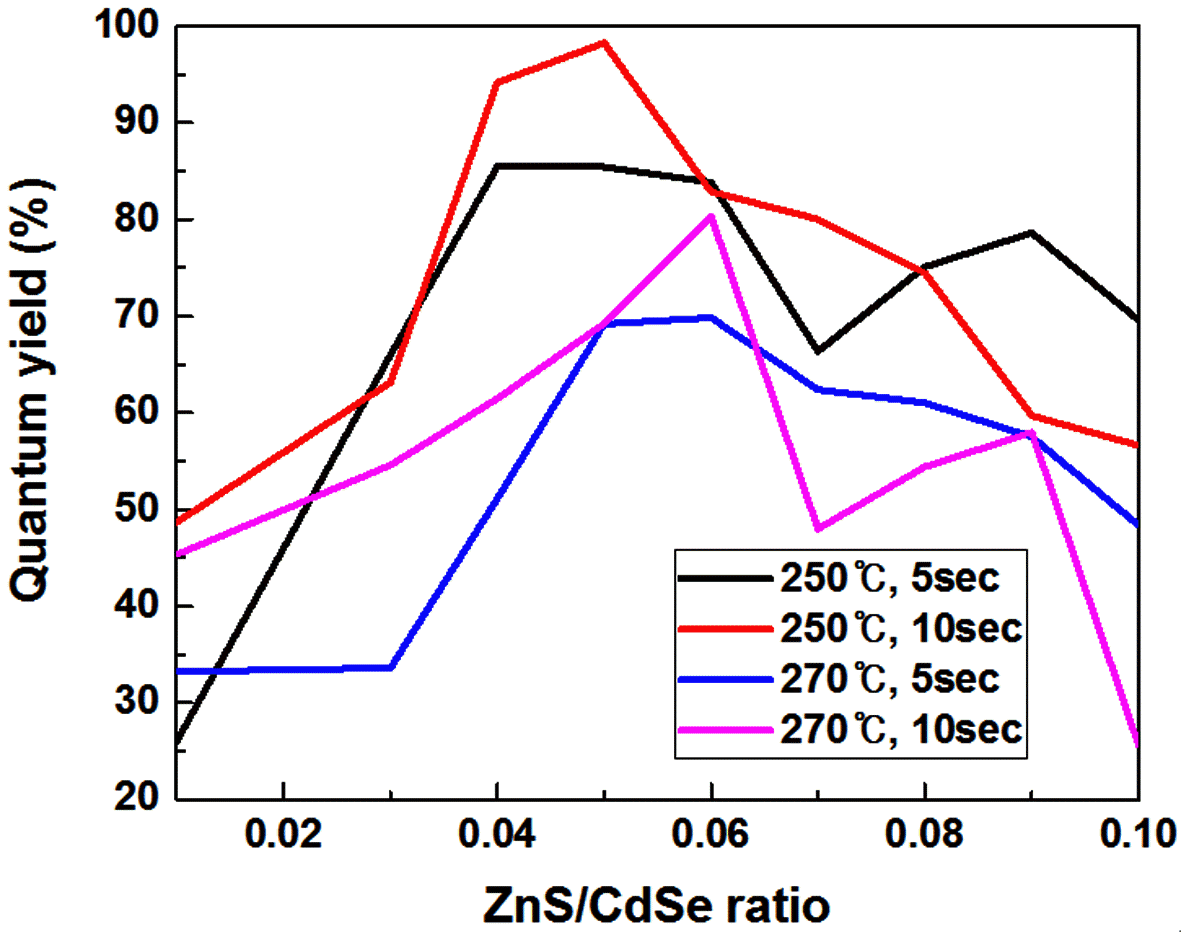- [Korean]
- Synthesis and analysis CdSe/ZnS quantum dot with a Core/shell Continuous Synthesis System Using a Microfluidic Reactor
-
Myung Hwan Hong, So Young Joo, Lee-Seung Kang, Chan Gi Lee
-
J Korean Powder Metall Inst. 2018;25(2):132-136. Published online April 1, 2018
-
DOI: https://doi.org/10.4150/KPMI.2018.25.2.132
-
-
 Abstract Abstract
 PDF PDF
Core/shell CdSe/ZnS quantum dots (QDs) are synthesized by a microfluidic reactor-assisted continuous reactor system. Photoluminescence and absorbance of synthesized CdSe/ZnS core/shell QDs are investigated by fluorescence spectrophotometry and online UV-Vis spectrometry. Three reaction conditions, namely; the shell coating reaction temperature, the shell coating reaction time, and the ZnS/CdSe precursor volume ratio, are combined in the synthesis process. The quantum yield of the synthesized CdSe QDs is determined for each condition. CdSe/ZnS QDs with a higher quantum yield are obtained compared to the discontinuous microfluidic reactor synthesis system. The maximum quantum efficiency is 98.3% when the reaction temperature, reaction time, and ZnS/CdSe ratio are 270°C, 10 s, and 0.05, respectively. Obtained results indicate that a continuous synthesis of the Core/shell CdSe/ZnS QDs with a high quantum efficiency could be achieved by isolating the reaction from the external environment.
- [Korean]
- Synthesis and analysis CdSe Quantum dot with a Microfluidic Reactor Using a Combinatorial Synthesis System
-
Myung Hwan Hong, Duk-Hee Lee, Lee-Seung Kang, Chan Gi Lee, Bum-Sung Kim, Nam-Hoon Kim
-
J Korean Powder Metall Inst. 2016;23(2):143-148. Published online April 1, 2016
-
DOI: https://doi.org/10.4150/KPMI.2016.23.2.143
-
-
 Abstract Abstract
 PDF PDF
A microfluidic reactor with computer-controlled programmable isocratic pumps and online detectors is employed as a combinatorial synthesis system to synthesize and analyze materials for fabricating CdSe quantum dots for various applications. Four reaction condition parameters, namely, the reaction temperature, reaction time, Cd/Se compositional ratio, and precursor concentration, are combined in synthesis condition sets, and the size of the synthesized CdSe quantum dots is determined for each condition. The average time corresponding to each reaction condition for obtaining the ultraviolet–visible absorbance and photoluminescence spectra is approximately 10 min. Using the data from the combinatorial synthesis system, the effects of the reaction conditions on the synthesized CdSe quantum dots are determined. Further, the data is used to determine the relationships between the reaction conditions and the CdSe particle size. This method should aid in determining and selecting the optimal conditions for synthesizing nanoparticles for diverse applications.
- [English]
- Materials Flow Analysis of Metallic Cobalt and Its Powder in Korea
-
Hyun Seon Hong, Lee-Seung Kang, Hong-Yoon Kang, Han-Gil Suk
-
J Korean Powder Metall Inst. 2014;21(3):235-240. Published online June 1, 2014
-
DOI: https://doi.org/10.4150/KPMI.2014.21.3.235
-
-
596
View
-
0
Download
-
2
Citations
-
 Abstract Abstract
 PDF PDF
The basis of the cobalt demand analysis by use was established via the investigation and analysis of the cobalt materials flow, and the overall cobalt metal material and parts industry structure in Korea was examined to determine the cobalt material flow. The markets of the cobalt material for machinery were studied, including their interrelations, via market and study trends, and relevant plans were examined. The results of the study indicated that the advanced core technology for advanced industry and technology-intensive industry development is required to structurally innovate the parts materials and basic materials industries and to upgrade the catch-up industry structure to the new frontier structure. -
Citations
Citations to this article as recorded by  - Exploring the potential for improving material utilization efficiency to secure lithium supply for China's battery supply chain
Xin Sun, Han Hao, Yong Geng, Zongwei Liu, Fuquan Zhao
Fundamental Research.2024; 4(1): 167. CrossRef - Trade structure and risk transmission in the international automotive Li-ion batteries trade
Xiaoqian Hu, Chao Wang, Xiangyu Zhu, Cuiyou Yao, Pezhman Ghadimi
Resources, Conservation and Recycling.2021; 170: 105591. CrossRef
|





